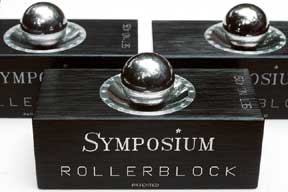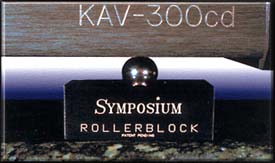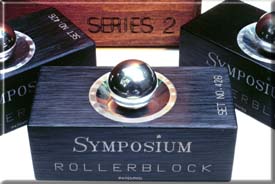Description
 The Series 2 Rollerblock body is made from solid, rectangular blocks of extremely hard alloy aircraft aluminum, and are finished with a black "hard-coat" anodizing. This relatively thin, special layer, harder than the aircraft aluminum itself (which is harder than some types of steel), improves contact efficiency and provides "constrained layer" resonance damping to the body. The bottom of the Series 2 Rollerblock has four beveled edges, and a matrix consisting of a pattern of holes. This unique design improves mechanical coupling between the body of the block and the supporting surface, like a cone, but with much greater stability. The matrix is filled with an acoustically absorbent material. On the top surface is a precision, spherical depression which is polished to a mirror finish, specified at 6 microns or better. This is an especially good finish, difficult to manufacture with precision. It is absolutely necessary, however, for state of the art results in a bearing isolation device.
The Series 2 Rollerblock body is made from solid, rectangular blocks of extremely hard alloy aircraft aluminum, and are finished with a black "hard-coat" anodizing. This relatively thin, special layer, harder than the aircraft aluminum itself (which is harder than some types of steel), improves contact efficiency and provides "constrained layer" resonance damping to the body. The bottom of the Series 2 Rollerblock has four beveled edges, and a matrix consisting of a pattern of holes. This unique design improves mechanical coupling between the body of the block and the supporting surface, like a cone, but with much greater stability. The matrix is filled with an acoustically absorbent material. On the top surface is a precision, spherical depression which is polished to a mirror finish, specified at 6 microns or better. This is an especially good finish, difficult to manufacture with precision. It is absolutely necessary, however, for state of the art results in a bearing isolation device.
One precision ball sits in the cup depression, and rests at the bottom. At least three Rollerblocks are placed beneath a component so that the component's chassis contacts the tops of the three balls, which now function as bearings. The component rests directly or indirectly upon the ball bearings, which rest at the bottom of the polished cup.
Theory of Operation
Vibration affects the performance of electronic components, usually with negative results, and originates from sources outside or inside the component. Rigid supports such as cones or spikes provide an escape route (in essence, a mechanical "ground" connection) for vibration that is more efficient than the typical rubberized feet of most components. These cone devices work by acting as a crude "waveguide" for mechanical energy, funneling energy to a point and forcing it to encounter the support structure at an angle of 90 degrees, the optimum approach angle for energy transfer (please see our web page on the nature of equipment cones in the "Our Technology" section for a more comprehensive discussion of how and why they work). While there are some directional characteristics to these devices in that more energy can flow from the large area side to the point side than the reverse, they are unable to isolate or absorb low frequency waves, as these readily traverse the pathway, moving the support structure, the cones, and ultimately the component.
Rubber Feet, Rubber Balls and Sorbothane Pads
Such low-frequency external vibration, including footfalls, sound, or shock waves from loudspeakers or other sources, can be reduced by introducing a high compliance between the component and the support, such as rubber air bag devices, or very soft, compliant materials, such as sorbothane rubber. While these devices seek to decouple the component in a crude approach to "isolation," they trap vibrations in the component itself by closing off its drainage path. In other words, what can't come in also can't get out. Worse, rubber-like materials store and release energy back into the component, and usually worsen results with a new source of secondary vibration. For a more comprehensive technical discussion of Rollerblock devices versus these compliant materials, please click here.
 Thus, it is desirous to isolate the component, but at the same time provide an escape route for internal vibration. Buzzing transformers, CD servo and disk motors, or even junctions of "singing" solid state devices (caused by the heat expansion and contraction of elements subjected to high current densities) can all be sources of internal vibration. By efficiently coupling the component's chassis to a non-resonant drainage sink, or mechanical "ground," we can provide an escape route for this vibration. The conduit for vibration flowing out of the component must be rigid, since flexible materials don't transmit energy well. But, since we also want to isolate the component from external vibration, this support must also be flexible. These requirements are mutually contradictory - akin to a "soft hardness!"
Thus, it is desirous to isolate the component, but at the same time provide an escape route for internal vibration. Buzzing transformers, CD servo and disk motors, or even junctions of "singing" solid state devices (caused by the heat expansion and contraction of elements subjected to high current densities) can all be sources of internal vibration. By efficiently coupling the component's chassis to a non-resonant drainage sink, or mechanical "ground," we can provide an escape route for this vibration. The conduit for vibration flowing out of the component must be rigid, since flexible materials don't transmit energy well. But, since we also want to isolate the component from external vibration, this support must also be flexible. These requirements are mutually contradictory - akin to a "soft hardness!"
Symposium Rollerblock systems (both the Series 2 as well as the entry-level Rollerblock Jr. fulfill this seemingly contradictory condition by combining a ball with a receptacle optimized for vibration transmission - the Rollerblock body. Precision machined from hard metal, it makes an excellent conductive path for vibratory energy, one far superior to woods, plastics, or rubber. The matrix on the Series 2 body bottom relegates surface contact to the ridges between the holes (with increased pressure) and serves as a mechanical waveguide. Vibratory energy travels through the steel ball, then the block body, and is "guided" down irregularly shaped pillars of metal (the "honeycomb" matrix). The energy is able to pass into the support structure at multiple points and at a more optimal angle, and this enables it to more efficiently penetrate the supporting surface. Acoustically absorbent material in the holes dissipates some of this energy as heat, and eliminates any resonances which might be caused by the hole cavities. Early experiments in different systems confirmed the effectiveness of the matrix to improve performance.
 Low frequency waves from the support structure cause physical displacement of the support and the Rollerblock body. As this "microearthquake" occurs, the captured ball in the Rollerblock's cup rolls - or "slips" - between the Rollerblock body and the equipment chassis. As the Rollerblock body moves, it pushes the ball and the component up the sides of the cup, dissipating the energy as work. At all times, however, there is contact between the component chassis and the Rollerblock body through the bearing, providing an unbroken, constant-metal drainage path for vibration otherwise trapped in the component, even while it is "decoupled" and able to move relative to the support.
Low frequency waves from the support structure cause physical displacement of the support and the Rollerblock body. As this "microearthquake" occurs, the captured ball in the Rollerblock's cup rolls - or "slips" - between the Rollerblock body and the equipment chassis. As the Rollerblock body moves, it pushes the ball and the component up the sides of the cup, dissipating the energy as work. At all times, however, there is contact between the component chassis and the Rollerblock body through the bearing, providing an unbroken, constant-metal drainage path for vibration otherwise trapped in the component, even while it is "decoupled" and able to move relative to the support.
The rolling, rigid, single ball bearing contact, mated to a receptacle optimized for mechanical energy transmission, effectively achieves a dual coupler/decoupler in a simple, elegant solution. The design is patented.
Why is Tungsten Carbide used for Ball Material?
Tungsten Carbide is preferred by most people for the ball material of the Rollerblock systems, who find it superior to steel (chromium or stainless), brass, glass, or ceramic. The reason for this has to do with Tungsten Carbide's unique combination of extreme hardness and high mechanical transmissivity. Its transmissivity, or ability to act as a mechanical conductor at higher frequencies, is very close to that of aluminum, thus making a coherent, reflection-free transmission path and match to the Rollerblock's aircraft aluminum body. By comparison, ceramic, although it exhibits excellent hardness, does not transmit energy nearly as well as Tungsten Carbide (Heat transmission is a direct indicator of a material's mechanical transmission ability. Ceramic's poor heat transmission capability is better exploited as a heat insulator, for instance, as a material for use in coffee mugs, rather than as the mechanical ground linkage in a ball bearing isolation device.)
Summary
Rollerblocks will make sonic improvements with all components, but the most dramatic usually occur with digital equipment, such as CD players, DACs and dedicated transports. Improvements in dynamics, transient response, and overall "air" and clarity suggest enhanced information retrieval from digital disks, probably due in part to Rollerblocks' unsurpassed ability to dissipate and isolate the minute rotational mode vibrations caused by these devices' spinning platter mechanisms. Beneath DVD players, greater clarity and image sharpness can be realized.
The reduction of vibration and its effects upon audio and video components brings the audiophile or videophile a significant step closer to optimal performance. The most highly reviewed footer device in the world is really not an accessory, but must be considered a component. As one reviewer said, "the Symposium Rollerblocks function just like a component which can stand the test of time for they will never be obsolete."